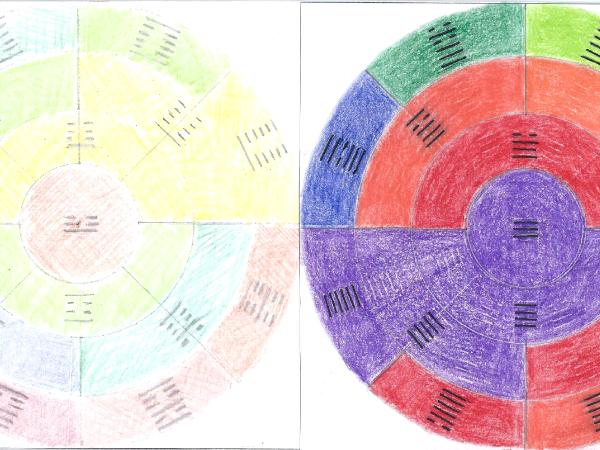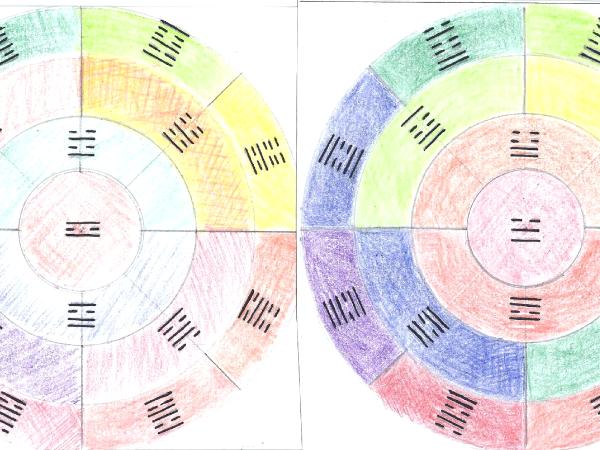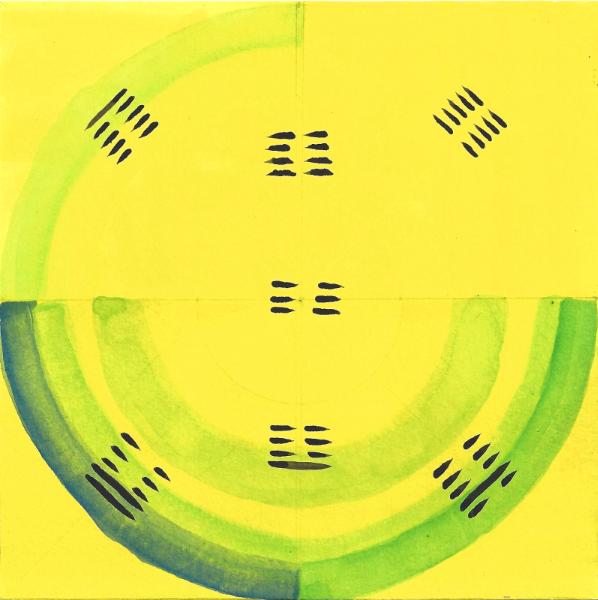My good and trusted friend James sent me the following link:
First I was struck by how this: . . . was another way of showing the logic game board I was working on: . . . so I was intrigued by the I Ching as a progressive map of simple binary choices:
3 choices leads to 8 possible states = the trigrams
4 choices leads to 16 possible states = quadragrams
5 choices leads to 32 possible states = pentagrams
6 choices leads to 64 possible states = the 64 hexagrams of the I Ching Oracle! The trigrams seem key and Nigel Richmond provides what I find to be clear and profound images for each.
Each quadragram is seen as a movement from one trigram to another - a change of state (or completion of a change) - and so on.
Here was something to explore! I started creating all sorts of crazy family trees of the trigrams and uncovering all sorts of fascinating patterns! I was sure that there was a series of eight paintings that would explore these sequences as developments in color!
Here are some of the discarded attempts: . . . wouldn't work as the choices, although simple, do not confine you to a limited area of the spectrum.
Then I had a beer in Palm Springs underneath an eight-colored rainbow umberella!
Hey - It was my birthday!
(That's Jon in the photo - in a particularly fine t-shirt!) Of course Newton's division of the rainbow can be seen as arbitrary!
Now to find ways of moving from any point to any other: Onto something -
. . . . . but it looks like bloody Tetris!
I wanted a form that could clearly show each stage as a binary choice branching from 1 - 2 - 4 - 8: How would the colors look?   Here's the rules (as explained to James via e-mail):
Taking the hexagrams as a sequence of binary choices working out from the first choice:
Yang (which without change becomes Ch'ien) = darkness = purple
Yin (which without change becomes the trigram K'un) = bright = yellow
Once these are developed (through two additional choices) into the eight trigrams we have:
Chie'n flanked by Tui and Sun as darker colors (two yang lines)
K'un flanked by Chen and K'en as brighter colors (two yin lines)
Li and K'an as intermediate (indeterminate) "vacillating" etc. or turning points.
I have taken "adding yin" as brightening and the red side of the spectrum so Tui is Rose (dark red/violet) and Chen is orange.
I have taken "adding yang" as darkening and the blue side of the spectrum so K'en is citrus and Sun is blue/violet.
Li then becomes intermediate vermilion (between scarlet and coral) and K'an some sort of mid-green.
I checked out the BaGua - there's a whole 'nother set of rules that I'm glad I didn't have access to before I started or I wouldn't have been able to feel out my own! The difference/addition is that the forms I am now working on show the progression or journey through three binary choices from one trigram as starting point to any of the eight. At each point you can simply either add yin or yang. Thus from any of the eight central trigrams, two quadragrams are possible (16 total). From each of these two quadragrams two further choices are possible resulting in four possible pentagrams (32 total). From each of these four pentagrams two more choices are possible resulting in eight hexagrams (64 total) whose upper trigrams in each case form a complete BaGua circle.
Thus each is a map of how to get to any chosen destination from any given starting point in no more than three choices.
Interesting discoveries (for me anyway):
- There are only four possible movement paths (hence only four colored drawings attached) for the eight trigrams i.e. trigrams form pairs. I was quite surprised by these pairings at first until I realized why! Here they are:
- Ch'ien & Sun
- Tui & K'an
- Li & K'en
- Chen & K'un
- And these four possible paths again form two inverted reflections:
- Chien/Sun is an inversion of Chen/K'un
- Tui/K'an is an inversion of Li/Ken
I am not interested in turning these into paintings as flat colors, which would simply be a diagram, so I am going to try layering each additional binary choice over the base trigram color so the central trigram will be one color, the quadragrams two, the pentagrams three and the hexagrams four colors with the outer rim always being the full BaGua. Here's a first go:  |
Oopsie - I didn't have enough circles to get to the hexagrams but it was a good "dry run" and did give me the opening to try putting the line patterns over the colors - which should make things clearer for I Ching enthusiasts but it is really just the same thing twice and I hope that the color sequences makes sense by themselves.
However this does present very clearly how things work:
The starting point (the center) in this instance is K'un "activity" or in color terms "brightness" - which in my vocabulary is yellow.
In the first instance there is a simple choice:
add yin = "stay bright" = remain K'un / yellow
add yang = "find a new horizon" = move to Ken / green
If the yin option is chosen these choices repeat at each stage.
If the yang option is chosen the next choice is:
Add yin = turn back towards activity "unable to rest" = move to K'an / blue
Add yang = "calcification" (as the tree turns sunlight not just into sugar and starch - from which energy can be restored - but cellulose) = move to Sun / Indigo
and so on! The third choice will always make all eight possible trigrams (my non-Newtonian rainbow!) available.
|